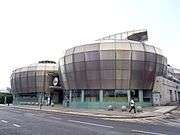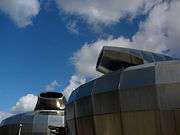National Centre for Popular Music
| Hallam Union Building of Sheffield | |
|---|---|
 The National Centre for Popular Music | |
| Former names | National Centre for Popular Music |
| Alternative names | The HUBs |
| General information | |
| Type | Museum |
| Architectural style | Avant-garde |
| Location | Sheffield, South Yorkshire |
| Address | Paternoster Row |
| Coordinates | 53°22′39″N 1°27′58″W / 53.377466°N 1.466036°WCoordinates: 53°22′39″N 1°27′58″W / 53.377466°N 1.466036°W |
| Current tenants | Sheffield Hallam University Students' Union |
| Completed | February 1999 |
| Inaugurated | 1 March 1999 |
| Cost | £15 million (Lottery funded by £11m) |
| Owner | Sheffield Hallam University |
| Technical details | |
| Structural system | Stainless steel drums |
| Design and construction | |
| Architect | Nigel Coates |
| Architecture firm | Branson Coates |
The National Centre for Popular Music was a museum in Sheffield, England, for contemporary music and culture, a £15 million project largely funded with contributions from the National Lottery, which opened on 1 March 1999, and closed in June 2000. Just prior to closure BBC Radio2 held a special gig to prize winners of around 75 people, to see Madness perform live with support from Paul Carrack. This was hosted by Billy Bragg and during the show Ian Dury was beamed in live and was interviewed by Suggs and Billy. Madness played It Must Be Love, My Old Man (Blockheads), One Step Beyond and Lovestruck before catching a train back to London from Sheffield. Suggs was late arriving at Sheffield as he had been at Alton Towers with his family. Various bands played this venue raising money for many charities.
Building design
The building, designed by Nigel Coates Architects following an architectural design competition managed by RIBA Competitions, consists of four giant stainless steel drums, surrounding an atrium area, the upper floor of which has a glazed roof. The drums, whose tops were built to rotate in to the wind, no longer rotate and have been left pointing in various directions.
Unusual features
The unusual building has acquired a number of local nicknames including the curling stones, drums and kettles. The Museum featured a 3D surround sound auditorium in one of the drums (called Soundscapes) created by Sheffield-based musician and producer Martyn Ware, who later used the same technology as the basis for his touring project "The Future of Sound". Two other drums were called Perspectives (music for different purposes) and Making Music (hands on). The final drum was used to show music around the world, but was supposed to accommodate changing exhibitions – this never happened as the museum closed. The interactive exhibitions were developed with the Philips electronics firm.
Facilities
The ground floor contained office space, a shop, a bar, a café and a further exhibition space. Access to this floor was free, with only the top floor forming the museum.



Commercial failure
High estimates of visitors
However, the Centre failed to attract enough visitors and cash flow to ensure its viability for its 79 workers – BBC News described the centre as having been "shunned" by visitors, and, despite a £2 million relaunch, the Centre closed for good in 2000. Ticket prices were about £21 for a family of four. It was hoped to attract 400,000 visitors a year. After seven months, 104,000 visitors turned up – mostly out of initial curiosity. At this point on 18 October 1999, the building's owners Music Heritage Ltd, called in PricewaterhouseCoopers to administer the day-to-day running. The company was to be liquidated in that November if administration was not successful. It was saved in the interim although it was owing £1.1m to 200 creditors. The estimates for visitors per year was reduced to 150,000. Martin King, the chief executive who took over from Stuart Rogers, then resigned in January 2000.
Subsequent use of building
It became a live music venue for a period from July 2001 and then being taken over by Sheffield Hallam University from September 2003, who bought it from Yorkshire Forward for £1.85m in February 2003. It is now the university's Students' Union.
See also
- List of music museums
- National Media Museum
- Millennium Dome
- Earth Centre, Doncaster – closed in September 2004
- British Music Experience – opened ten years later in March 2009 in London
External links
- Sheffield Hallam University Students Union
- Made in Sheffield
- Mallinder, Stephen. (September 2007) Sheffield is not sexy, Nebula, vol 4, issue 3.